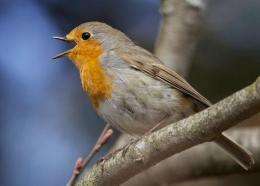Quantum robins lead the way

(PhysOrg.com) -- Did you know that the humble robin uses quantum physics?
Researchers have been investigating the mechanism which enables birds to detect the Earth's magnetic field to help them navigate over vast distances. This ability, known as magnetoreception, has been linked to chemical reactions inside birds' eyes.
Now a team from Oxford University and Singapore believe that this 'compass' is making use of something called quantum coherence.
In a forthcoming article in Physical Review Letters the team report how they anaylsed data from an experiment by Oxford and Frankfurt scientists on robins.
The experiment showed that the magnetic compass used by robins could be distrupted by extremely small levels of magnetic 'noise'. When this noise, a tiny oscillating magnetic field, was introduced it completely disabled the Robins' compass sense which then returned to normal once the noise was removed - good news for robins which have to navigate on the long migration route to Scandinavia and Africa and back every year.
In their analysis the Oxford/Singapore team show that only a system with components operating at a quantum level would be this sensitive to such a small amount of noise.
'Quantum information technology is a field of physics aimed at harnessing some of the deepest phenomena in physics to create wholly new forms of technology, such as computers and communication systems,' said Erik Gauger of Oxford University's Department of Materials, an author of the paper.
'Progress in this area is proving to be very difficult because the phenomena that must be harnessed are extremely delicate. It would normally be thought almost inconceivable that a living organism could have evolved similar capabilities.'
Co-author Simon Benjamin from Singapore explained: 'Coherent quantum states decay very rapidly, so that the challenge is to hold on to them for as long as possible. The molecular structures in the bird's compass can evidently keep these states alive for at least 100 microseconds, probably much longer.'
'While this sounds like a short time, the best comparable artificial molecules can only manage 80 microseconds at room temperature. And that's in ideal laboratory conditions.'
Erik and Simon now hope that further research into how birds harness these quantum states could enable researchers to mimic them and help in the development of practical quantum technologies.
Provided by Oxford University




















